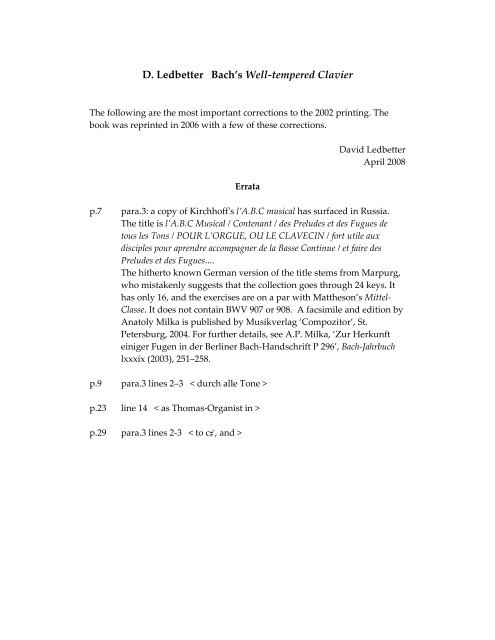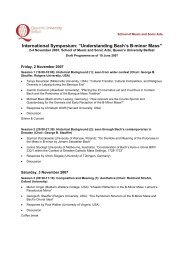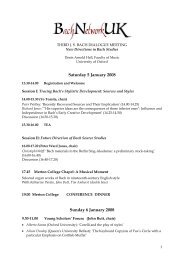D. Ledbetter Bach's Well-tempered Clavier
D. Ledbetter Bach's Well-tempered Clavier
D. Ledbetter Bach's Well-tempered Clavier
Create successful ePaper yourself
Turn your PDF publications into a flip-book with our unique Google optimized e-Paper software.
D. <strong>Ledbetter</strong> Bach’s <strong>Well</strong>‐<strong>tempered</strong> <strong>Clavier</strong><br />
The following are the most important corrections to the 2002 printing. The<br />
book was reprinted in 2006 with a few of these corrections.<br />
Errata<br />
David <strong>Ledbetter</strong><br />
April 2008<br />
p.7 para.3: a copy of Kirchhoffʹs l’A.B.C musical has surfaced in Russia.<br />
The title is l’A.B.C Musical / Contenant / des Preludes et des Fugues de<br />
tous les Tons / POUR L’ORGUE, OU LE CLAVECIN / fort utile aux<br />
disciples pour aprendre accompagner de la Basse Continue / et faire des<br />
Preludes et des Fugues....<br />
The hitherto known German version of the title stems from Marpurg,<br />
who mistakenly suggests that the collection goes through 24 keys. It<br />
has only 16, and the exercises are on a par with Mattheson’s Mittel‐<br />
Classe. It does not contain BWV 907 or 908. A facsimile and edition by<br />
Anatoly Milka is published by Musikverlag ‘Compozitor’, St.<br />
Petersburg, 2004. For further details, see A.P. Milka, ‘Zur Herkunft<br />
einiger Fugen in der Berliner Bach‐Handschrift P 296’, Bach‐Jahrbuch<br />
lxxxix (2003), 251–258.<br />
p.9 para.3 lines 2–3 < durch alle Tone ><br />
p.23 line 14 < as Thomas‐Organist in ><br />
p.29 para.3 lines 2‐3 < to c��, and >
p.35 Chapter Two. This chapter was written before Andreas Sparschuh, of<br />
the Technische Universität Darmstadt, proposed an interpretation of<br />
Bach’s temperament based on the decorative patterns at the top of the<br />
1722 title‐page (paper read at the Deutsche Mathematiker<br />
Vereinigung Jahrestagung, Mainz 1999, for which he earned the<br />
Golden Tuning Fork of the German Tuners’ Association). A different<br />
interpretation was subsequently proposed by Bradley Lehman (Early<br />
Music 2/2005 and 5/2005, with replies 8/2005). Two responses to<br />
Lehman’s conjecture were published in Early Music 11/2006, by Mark<br />
Lindley and Ibo Ortgies, and by John O’Donnell. While all these<br />
conjectures are of great interest, I see no reason to revise my<br />
fundamental points: 1) that it is most unlikely that Bach stayed with a<br />
single method of tuning throughout his career, and 2) that as a<br />
practical musician he is unlikely to have adhered rigidly to a<br />
mathematically formulated tuning at any stage of his career. The story<br />
of Johann Nikolaus Bach’s competition with Neidhardt (and his<br />
monochord, see pp.39–40) would seem to corroborate this.<br />
p.41 fn 31: Kerala Snyder has recently withdrawn her proposal that the<br />
Marienkirche organs were tuned to Werckmeister III in 1683 (Dietrich<br />
Buxtehude, Rochester NY: University of Rochester Press, 2/2007,<br />
pp.84–6).<br />
p.44 para.1 line 4 < on g�� ; the ><br />
p.80 para.1 line 8 < delivery or pronunciatio/executio ><br />
p.90 para.1 table: numbers should be aligned to show correspondences:<br />
p.91 para.1 table: ditto<br />
1 2 3 4 5 6 7 8 9 10<br />
10 9 8 7 6 5 4 3 2 1<br />
1 2 3 4 5 6 7 8 9 10 11 12<br />
12 11 10 9 8 7 6 5 4 3 2 1<br />
p.96 para.1 line 8 < Bach also begins ><br />
p.127 para 3 line 5 < in a way ><br />
p.164 para.1 line 7 < perforatum >
p.179 para.1 second last line < top cʺʹ� ><br />
para 2 line 11 < �.�� � � � � ><br />
p.191 para.2 line 2 < to the � time signature ><br />
p.200 para.3 line 12 < with 4� on the upper ><br />
p.210 The discussion of the G sharp minor fugue needs some further nuance<br />
in that an ordinary tonal answer for Kerll’s subject would deform it to<br />
d c� f� e f� g f� e� d. Bach’s modulating version very neatly makes a<br />
circle of subject and answer, beginning and ending on G, truly a<br />
connoisseur’s engagement with Kerll’s Fuga.<br />
p.211 Ex.7.25 b.5 in b) version, tenor should be e�<br />
p.212 para.1 line 3 < modal subject ><br />
p.256 para.2 line 9 < � and �� values ><br />
p.270 para 1 line 8 < that they cannot ><br />
p.292 para.3 line 5 < 1974 p.4 > delete c<br />
p.303 para 1 line 6 < 10th at b.69 ><br />
p.318 para.3 last line, numbers should end < 1 2 :| > colon before line<br />
p.346 note 21: The Heinitz unfretted clavichord of 1716 has now been<br />
discussed in much more detail by Richard Troeger, ‘Bach, Heinitz,<br />
Specken, and the early bundfrei clavichord’, Music and its Questions:<br />
Essays in Honor of Peter Williams (ed. T. Donahue) pp.143–66<br />
(Richmond VA: OHS Press, 2007).<br />
p.347 top line < FF–dʺʹ ><br />
line 3 < C/E–cʺʹ >
p.353 note 6 line 1 < Parnassus was published by 1736 at the latest, but ><br />
end the fn at < earlier. > delete ‘than their publication date’.<br />
[should work out line‐wise with addition to line 1]<br />
p.355 note 30 line 3 < fugues in 16 keys: L’ABC musical (Amsterdam c.1734);<br />
ed. A.Milka (St Petersburg: Musikverlag ‘Kompositor’, 2004). ><br />
p.356 note.5 line 11 < p.31) and Bernhard (c.1649); it chimes ><br />
p.374 Fischer, line 4 < 1736 ><br />
p.386 Franklin line 4 < (1989b) > b<br />
Hermlink line 2 < Preußischer > r<br />
p.395 Stinson line 7 < 1995b > + b<br />
p.405 Fischer, J.C.F. second last line < (n.d.) > not 1738<br />
In July 2003 I received a letter from the late Madame Denise Restout, who was<br />
Wanda Landowska’s personal assistant and published a translation of<br />
Landowska’s writings on music in 1965. She has put me right about some of<br />
Landowska’s views: those of us not privileged to have known Madame<br />
Landowska have to rely on written records, which can be misleading. You<br />
could say the same of Bach.<br />
‘One point in particular I would like to refute and rectify. In Chapter One<br />
<strong>Clavier</strong> you wrote: “Wanda Landowska added (1907–1911) an element of her<br />
own hysterical prejudice against the clavichord…” and later: “her dislike of<br />
the clavichord was lifelong and passed on to generations of students”. This is<br />
TOTALLY FALSE. Landowska loved the clavichord for what it was and what<br />
it could do – she owned two beautiful ancient ones, and in 1942 Challis built a<br />
new one for her (on which I still teach today!). She played many types of<br />
clavichords…. What Landowska objected to was playing on that instrument<br />
music that obviously was not meant for it. The clavichord’s tonal limitations<br />
do not allow important contrasts of sonority, nor of timbre coloration, as does<br />
the harpsichord, and which are needed for many of J.S.Bach’s works….<br />
You also quote her as having said of Kirkpatrick’s recording of The <strong>Well</strong>‐<br />
<strong>tempered</strong> <strong>Clavier</strong> on the clavichord: “it is a pity that he could not afford a
harpsichord!” She certainly never said that – the type of hostile gossip I mean.<br />
Kirkpatrick, who was her student for a few years, openly had a great dislike<br />
for Landowska’s personality. Yet he had to admit in his memoires how great<br />
she was and how much he had learned from her.’





